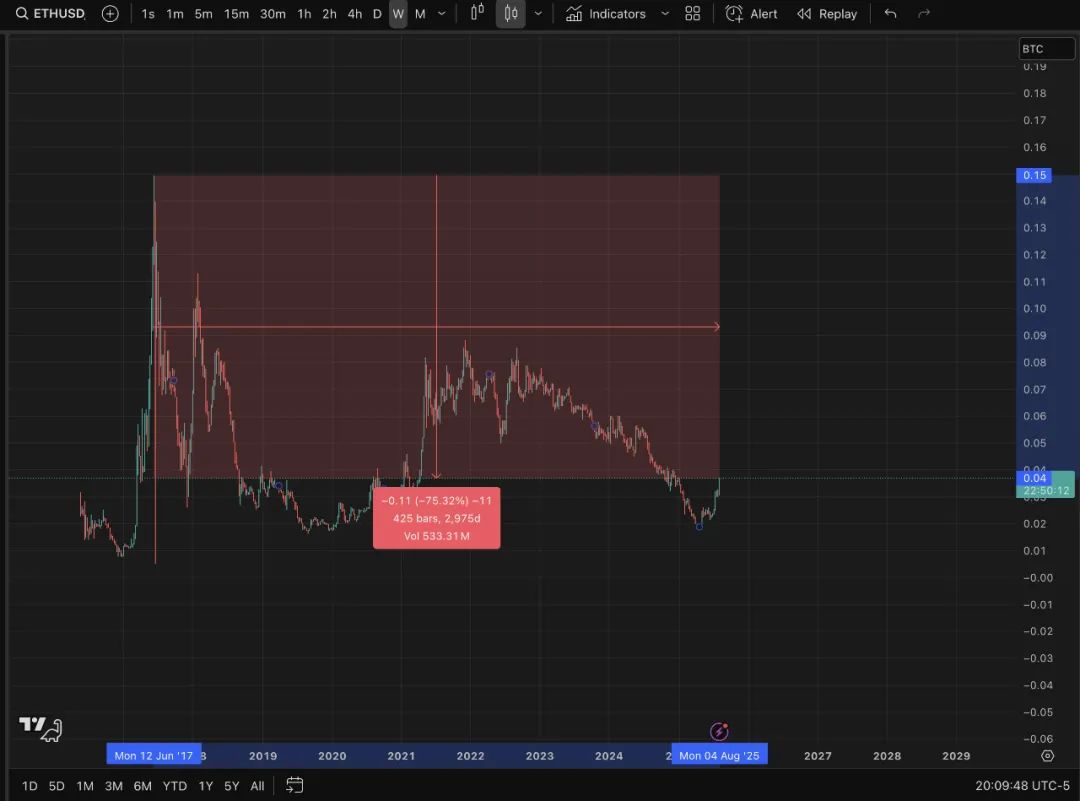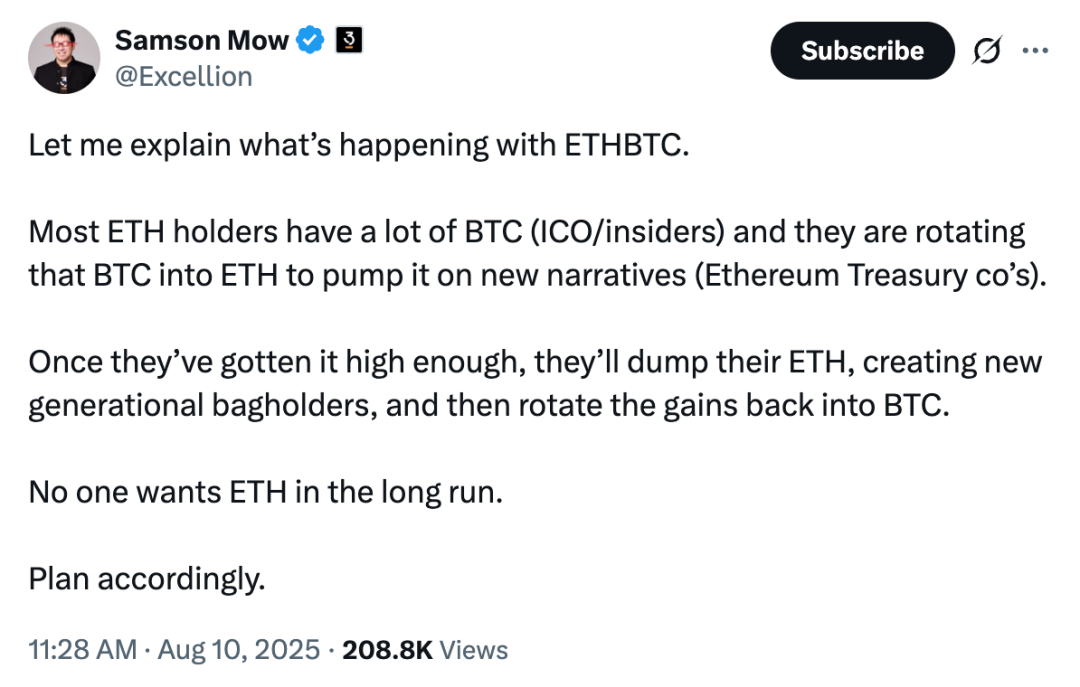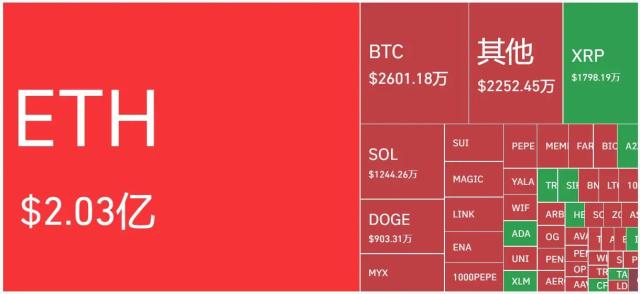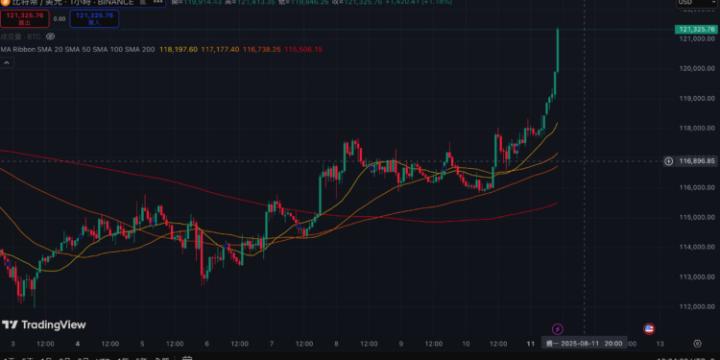Since ETH fell below $1,400 in April, with ETH/BTC dropping to 0.017, approaching a 7-year low point, it then made a desperate rebound, rising all the way to over $4,200, approaching the 2021 high of $4,900. ETH/BTC has doubled to 0.035, which has sparked more bullish voices.
However, by zooming out, we can clearly see that although ETH/BTC has doubled to near 0.04, it is still far from the exchange rate of nearly 0.09 during the previous bull market in 2021 and the historical high of nearly 0.15 during the bull market in 2017.

Assuming BTC remains stationary at $120,000, if the ETH/BTC exchange rate returns to 0.09, it would mean ETH would rise to over $10,000; and if it returns to 0.15, it would be close to $18,000 to $20,000.
I remember someone shouting about $30,000 during the craziest time of the last bull market cycle, calling it an innovation at the level of human civilization. Of course, nothing came of it afterward. Those crazy people and the ordinary people drawn into the pit don't know whether they have persisted until now or have already cut their losses and escaped.
Looking back at the chain's own [2022 Year-end Report] written during the extreme cold of the bear market in December 2022, when BTC fell to $15,000-$16,000 and ETH to $1,150-$1,200, it also projected that ETH might reach $20,000-$30,000 in the next bull market, but this was premised on BTC first reaching $300,000. In other words, the ETH/BTC exchange rate would still be around 0.06-0.1.
Now, two and a half years later, 0.06 seems like a blessing, and 0.1 seems quite challenging.
If ETH, which continues to be issued at near-zero cost after transitioning to PoS, can outperform and surpass BTC, which has continuously reduced production through halving, that would be a truly earth-shattering event.
Some might argue that PoS stakers have given up the liquidity of their staked ETH, and from an economic perspective, issuing new ETH as interest compensation is entirely justified. Regarding the legitimacy of earning interest, compared to explicitly staked ETH, ETH hoarders who have not clearly staked will not receive any compensation for giving up liquidity. We can view all long-term BTC hoarders who have given up liquidity, including ancient whales, long-term holders, and recent institutional holders, as equivalent stakers. The BTC system's method of compensating or incentivizing long-term holding is not to issue new coins specifically to them, but to allow all BTC to appreciate equally, thus more equitably giving time value benefits to all holders.
In fact, since staking can be unstaked at any time with no lock-up commitment, and with derivatives like sETH that indirectly release staked ETH liquidity, and re-staking and other secondary derivatives that further expand liquidity, the value appreciation from staking will not exceed the value appreciation from holding BTC like a "diamond hand". This is currently the chain's personal intuition, which may be proven by economic academic research in the future.
Therefore, based on this assumption, the chain believes that hoarding BTC is equivalent to staking ETH, which is a completely reasonable judgment.
Price is always equal to total value divided by total coin supply. If the total value of BTC and ETH increases by one unit, but BTC's total supply increases less and ETH's total supply increases more, then the value increment of each ETH will be smaller than each BTC, which will ultimately be reflected in the secondary market price, observing the cyclical downward oscillation of the ETH/BTC exchange rate.
As for why ETH/BTC can rise in a local time window, or short-term outperformance, its logic is very similar to other Altcoins, as explained by netizen @Excellion on why ETH/BTC is difficult to regain its former glory:

"Let me explain the current state of ETH/BTC.
Most ETH holders (ICO participants/insiders) already own a lot of BTC, and they are rotating BTC funds into ETH, using the new narrative (Ethereum strategic reserve company concept) to pump the price.
Once they pull ETH to a high enough position, they will sell ETH tokens, creating a new generation of bagholders, ultimately rotating the profit back to BTC.
Fundamentally, no one wants to hold ETH long-term."
Essentially, BTC is a store of value, while Altcoins (including ETH) are tools, "sickles" for harvesting value.
You ask if ETH is good? Ask the wheat-cutting farmer, is a sickle good or not? Of course, it's good.
First, understand whether you are the farmer or the wheat.
Of course, if you just use the tool as a tool, spending money as consumption, to buy products or services, like buying a worthwhile phone, then you are not being harvested.
If you are an insider with a large number of sickle tokens, then you can read the above in reverse. Such harvesting opportunities are your favorite get-rich-quick game.
The best game is to hold the sickle yourself, with abundant wheat to harvest, a game of guaranteed profit. (Like Altcoins for insiders, USD for the Federal Reserve)
The next best game is one where everyone is equal, with no differential advantages, a fair game. (Like BTC)
The worst game is being the wheat, a game where you are at the mercy of others. (Like Altcoins for retail investors, USD for non-US countries)
Choose carefully.
Twitter: https://twitter.com/BitpushNewsCN
Bitpush Telegram Group: https://t.me/BitPushCommunity
Bitpush Telegram Subscription: https://t.me/bitpush







